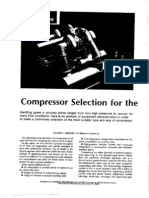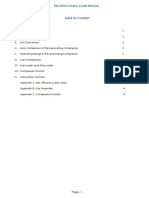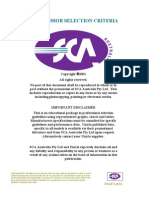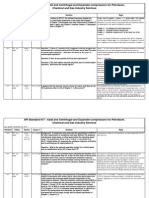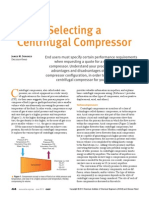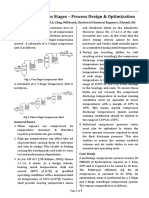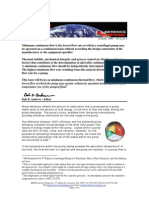0 ratings0% found this document useful (0 votes)
683 viewsCentrifugal Compressor Performance Calculations
Centrifugal Compressor Performance Calculations
Uploaded by
Freddy RoaThis document provides information and sample calculations for estimating the performance of centrifugal compressors. It discusses the types of centrifugal compressor cases and flow arrangements. It also covers the adiabatic and polytropic process methods for evaluating compressors. The document provides a sample performance calculation to determine the required compressor frame size, number of stages, speed, power, and discharge temperature to compress a gas mixture from 30 to 100 psia. It determines the values are a 3-stage compressor requiring 4,397 hp rotating at 5,030 rpm with a discharge temperature of 159°F.
Copyright:
© All Rights Reserved
Available Formats
Download as PDF, TXT or read online from Scribd
Centrifugal Compressor Performance Calculations
Centrifugal Compressor Performance Calculations
Uploaded by
Freddy Roa0 ratings0% found this document useful (0 votes)
683 views4 pagesThis document provides information and sample calculations for estimating the performance of centrifugal compressors. It discusses the types of centrifugal compressor cases and flow arrangements. It also covers the adiabatic and polytropic process methods for evaluating compressors. The document provides a sample performance calculation to determine the required compressor frame size, number of stages, speed, power, and discharge temperature to compress a gas mixture from 30 to 100 psia. It determines the values are a 3-stage compressor requiring 4,397 hp rotating at 5,030 rpm with a discharge temperature of 159°F.
Copyright
© © All Rights Reserved
Available Formats
PDF, TXT or read online from Scribd
Share this document
Did you find this document useful?
Is this content inappropriate?
This document provides information and sample calculations for estimating the performance of centrifugal compressors. It discusses the types of centrifugal compressor cases and flow arrangements. It also covers the adiabatic and polytropic process methods for evaluating compressors. The document provides a sample performance calculation to determine the required compressor frame size, number of stages, speed, power, and discharge temperature to compress a gas mixture from 30 to 100 psia. It determines the values are a 3-stage compressor requiring 4,397 hp rotating at 5,030 rpm with a discharge temperature of 159°F.
Copyright:
© All Rights Reserved
Available Formats
Download as PDF, TXT or read online from Scribd
Download as pdf or txt
0 ratings0% found this document useful (0 votes)
683 views4 pagesCentrifugal Compressor Performance Calculations
Centrifugal Compressor Performance Calculations
Uploaded by
Freddy RoaThis document provides information and sample calculations for estimating the performance of centrifugal compressors. It discusses the types of centrifugal compressor cases and flow arrangements. It also covers the adiabatic and polytropic process methods for evaluating compressors. The document provides a sample performance calculation to determine the required compressor frame size, number of stages, speed, power, and discharge temperature to compress a gas mixture from 30 to 100 psia. It determines the values are a 3-stage compressor requiring 4,397 hp rotating at 5,030 rpm with a discharge temperature of 159°F.
Copyright:
© All Rights Reserved
Available Formats
Download as PDF, TXT or read online from Scribd
Download as pdf or txt
You are on page 1of 4
120 Rules of Thumb for Mechanical Engineers
Centrifugal Compressor Performance Calculations
Centrifugal compressors are versatile, compact, and
generally used in the range of 1,000 to 100,000 inlet cubic
ft per minute (ICFM) for process and pipe line compression
applications.
Centrifugal compressors can use either a horizontal or a
vertical split case. The type of case used will depend on the
pressure rating with vertical split casings generally being
used for the higher pressure applications. Flow arrange-
ments include straight through, double flow, and side flow
configurations.
Centrifugal compressors may be evaluated using either
the adiabatic or polytropic process method. An adiabatic
process is one in which no heat transfer occurs. This doesn't
imply a constant temperature, only that no heat is trans-
ferred into or out of the process system. Adiabatic is nor-
mally intended to mean adiabatic isentropic. A polytropic
process is a variable-entropy process in which heat transfer
can take place.
When the compressor is installed in the field, the power
required from the driver will be the same whether the pro-
cess is called adiabatic or polytropic during design. There-
fore, the work input will be the same value for either pro-
cess. It will be necessary to use corresponding values when
making the calculations. When using adiabatic head, use
adiabatic efficiency and when using polytropic head, use
polytropic efficiency. Polytropic calculations are easier to
make even though the adiabatic approach appears to be
simpler and quicker.
The polytropic approach offers two advantages over the
adiabatic approach. The polytropic approach is indepen-
dent of the thermodynamic state of the gas being com-
pressed, whereas the adiabatic efficiency is a function of
the pressure ratio and therefore is dependent upon the ther-
modynamic state of the gas.
If the design considers all processes to be polytropic, an
impeller may be designed, its efficiency curve determined,
and it can be applied without correction regardless of pres-
sure, temperature, or molecular weight of the gas being
compressed. Another advantage of the polytropic approach
is that the sumof the polytropic heads for each stage of
compression equals the total polytropic head required to
get from state point 1 to state point 2. This is not true for
adiabatic heads.
Sample Performance Calculations
Determine the compressor frame size, number of stages,
rotational speed, power requirement, and discharge tem-
perature required to compress 5,000 lbm/min of gas from
30psia at 60F to 100 psia. The gas mixture molar compo-
sition is as follows:
Ethane 5%
n-Butane 15 %
Propane 80 %
The properties of this mixture are as follows:
MW =45.5
P, =611 psia
T, =676"R
cp =17.76
kl =1.126
Z1=0.955
Before proceeding with the compressor calculations, let's
review the merits of using average values of Z and k in cal-
culating the polytropic head.
The inlet compressibility must be used to determine the
actual volume entering the compressor to approximate the
size of the compressor and to communicate with the vendor
via the data sheets. The maximumvalue of 8 is of interest
and will be at its maximumat the inlet to the compressor
where the inlet compressibility occurs (although using the
average compressibility will result in a conservative esti-
mate of e).
Compressibility will decrease as the gas is compressed.
This would imply that using the inlet compressibility
would be conservative since as the compressibility de-
creases, the head requirement also decreases. If the varia-
tion in compressibility is drastic, the polytropic head re-
Pumps and Compressors 121
quirement calculated by using the inlet compressibility
would be practically useless. Compl.essor manufacturers
calculate the performance for each stage and use the inlet
compressibility for each stage. An accurate approximation
may be substituted for the stageby-stage calculation by
calculating the polytropic head for the overall section using
the average compressibility. This technique d t s in over-
estimating the first half of the impellers and Underestimat-
ing the last half of the impellers, thmby calculating a
polytropic head very near that calculated by the stapby-
stage technique.
Determine the inlet flow volume, Q1:
where m =mass flow
Z1= inlet compdbility factor
Pi =inletpresfllre
R =gas constant =1,545/MW
TI .- inlet temperature "R
Q1 =5,OOO[(O.955)(1,545)(80 +~ 8 0 ) / ( ~ 5 . 5 ) ( 1 ~ ) ~ ~ ) ]
=19,517 ICFM
Refer to Bible 3 and select a compressor frame that will
handle a flow rate of 19,517 ICFM. A name C Compressor
will handle a range of 13,000 to 31,000 ICFM and would
have the following nominal d ak
!&,- =10,OOOft-lb/lbm (nominal polytropic head)
np =77% (polytropic &iency)
N , , =5,900 rpm
Determine the pl.iessure ratio, rp.
rp =PB/P1 =100/30 =3.33
Determine the approximate discharge temperature, Tg.
nh - 1 =[Wk - 11%
=[1.126/(1.126 - 1.000)](0.77)
=6.88
T2 =Tl(rp)(n-l)/n
=(60 +460)(3.33)"f3.88
=619"R =159F
Determine the average compressibility, Z,.
Z1= 0.955 (fromgas properties calculation)
where Z1= inlet compressibility
(PJ2 =pzlp,
=100/611
=0.164
( TJB =TdTC
=619/676
=0.916
nbl e 3
Typical Centrifugal Compressor Frame Data*
Nominal
Impeller Diameter
Nominal Nominal
Polytropic Rotational
Nominal
Polytropic Head Nominal Inlet Volume Flow
English Metric Engllsh Metric Efficiency Speed Engllrh MeMc
Frame (ICFM) Im'/h) Ift-lbf/lbml (k-Nm/kg) 1%) IRPM) (in) Imm)
A 1 ,ONk7,000 1.7oO-12.OOO 1o.ooo 30 76 11,000 16 406
B 6,000-1 8 ,OW 10.000-31 ,000 10,000 30 76 7.700 23 584
C 13,ooO-31 .OOO 22,000-53.000 10,ooo 30 n 5.900 30 762
D 23,000-44.000 39.000-75.000 10,ooo 30 n 4.900 36 914
E 33 ,ooo65 .OOO 56.000-1 10,000 10,000 30 78 4,000 44 i.im
F 48.000-100.000 82.OCS170.000 10.000 30 78 3.300 54 1.370
*While this table is based on 8 survey of currently available equipment, the instance of any machinery duplicating this table would be purely
coincidental.
122 Rules of Thumb for Mechanical Engineers
e
Figure 10. Maximum polytropic head per st ageEngl i sh system.
Refer to Figure 5 to find Zz, discharge compressibility. temperature but also at the estimated discharge tempera-
ture.
Zz =0.925
The suggested approach is as follows:
z, =(Z, +Z2)/2
=0.94
Determine average k-value. For simplicity, the inlet
value of k will be used for this calculation. The polytropic
head equation is insensitive to k-value (and therefore n-
value) within the limits that k normally varies during com-
pression. This is because any errors in the n/(n - 1) multi-
plier in the polytropic head equation tend to balance
corresponding errors in the (n - l)/n exponent. Discharge
temperature is very sensitive to k-value. Since the k-value
normally decreases during compression, a discharge tem-
perature calculated by using the inlet k-value will be con-
servative and the actual temperature may be several de-
grees higher-possibly as much as 2540F. Calculating
the average k-value can be time-consuming, especially for
mixtures containing several gases, since not only must the
mol-weighted cp of the mixture be determined at the inlet
1. If the k-value is felt to be highly variable, one pass
should be made at estimating discharge temperature
based on the inlet k-value; the average k-value should
then be calculated using the estimated discharge tem-
perature.
2. If the k-value is felt to be fairly constant, the inlet k-
value can be used in the calculations.
3. If the k-value is felt to be highly variable, but suffi-
cient time to calculate the average value is not avail-
able, the inlet k-value can be used (but be aware of
the potential discrepancy in the calculated discharge
temperature).
kl =k, =1.126
Determine average n/(n - 1) value from the average k-
value. For the same reasons discussed above, use n/
(n - 1) =6.88.
Table 4
Approximate Mechanical Losses as a Percentage of Gas Power
Requirement.
~
Gas Power Requirement
Mechanical
English Metric Losses, L,
(hp) IkWI (%I
0-3.000
3.000-6.000
6,000-10.000
10,000+
0-2,500
2,500-5,000
5,000-7.500
7,500+
3
2.5
2
1.5
*There is no way to estimate mechanical losses from gas power requirements. This table
will. however, ensure that mechanical losses are considered and yield useful values for es-
timating purposes.
Pumps and Compressors 123
Determine polytropic head, H,:
Hp =Z,RTl(n/n - l)[rp(n-L)'n - 11
=(0.94) (1,545/45.5) (520) (6.88) (3 .33)'/".88 - 11
=21,800 ft-lbf/lbm
Determine the required number of compressor stages, 8:
8 =[(26.1MW)/(kiZ1T1)]0.5
=[ (26.1) (45.5)/ (1.126) (0.955) (520)]0.5
=1.46
max Hp/stage from Figure 10 using 8 =1.46
Number of stages =Hp/max. H,/stage
=21,800/9,700
=2.25
=3 stages
Determine the required rotational speed:
Mechanical losses (L,) =2.5% (from Table 4)
L, =(0.025)(4,290)
=107 hp
PWR, =PWR, +L,,,
=4,290 +107
=4,397 hp
Determine the actual discharge temperature:
TZ =Tl(rp)(n-l)/n
=520(3.33)"6.88
=619"R
=159F
The discharge temperature calculated in the last step is
the same as that calculated earlier only because of the deci-
sion to use the inlet k-value instead of the average k-value.
Had the average k-value been used, the actual discharge
temperature would have been lower.
N =N,,[HP/Hpn,, x no.
=5,900[21,800/(10,000) (3)]0.5
=5,030 rpm
Determine the required shaft power:
Source
PWR, =mHp/33,000np
=(5,000)(21,800)/(33,000)(0.77)
=4,290 hp
Lapina, R. P., Estimating Centrifugal Compressor
Performance, Houston: Gulf Publishing Company, 1982.
Estimate hp required to compress natural gas
Toestimate the horsepower to compress a million cubic
ft of gas per day, usethe following formula:
BHPlMMcfd =-
where R =compression ratio. Absolute discharge pressure
J =supercompressibility factor- assumed 0.022
divided by absolute suction pressure
per 100 psia suction pressure
Example. How much horsepower should be installed to
raise the pressure of 10 million cubic f t of gas per day from
185.3 psi to 985.3 psi?
This gives absolute pressures of 200 and 1,000.
1,000 - 5.0
then R =- -
200
Substituting in the formula:
5.0 5.16 +124 x .699
BHP/MMcfd =
5.0 +5 X 0.044 .97 - .03 x 5
Compression Rot i o
=106.5 hp =BHP for 10 MMcfd
=1,065 hp
Where the suction pressure is about 400 psia, the brake
horsepower per MMcfd can be read from the chart.
The above formula may be used to calculate horsepower
requirements for various suction pressures and gas physical
properties to plot a family of curves.
You might also like
- A Method To Estimate The Performance Map of A Centrifugal Compressor StageDocument10 pagesA Method To Estimate The Performance Map of A Centrifugal Compressor StagesamiNo ratings yet
- Compressor CharacteristicDocument6 pagesCompressor CharacteristicSyedMeherAli100% (1)
- Polytropic CompressionDocument22 pagesPolytropic CompressionSonal Power Unlimitd50% (2)
- Project 6 AmmoniaDocument10 pagesProject 6 AmmoniaAhmed AliNo ratings yet
- Gas Compression IIDocument13 pagesGas Compression IIAnuraag Mulpuri100% (1)
- Compressor Selection Process IndDocument15 pagesCompressor Selection Process Indadoptvn100% (1)
- SOP CalculationDocument8 pagesSOP Calculationmatteo2009100% (1)
- How To Select Turbomachinery For Your ApplicationDocument10 pagesHow To Select Turbomachinery For Your ApplicationSubhash PadmanabhanNo ratings yet
- Design Procedure of Centrifugal CompressorsDocument16 pagesDesign Procedure of Centrifugal CompressorsSrujana Kandagatla100% (1)
- Engineering Design Guidelines Compressor Sizing and Selection Rev4.1Document37 pagesEngineering Design Guidelines Compressor Sizing and Selection Rev4.1Samuel KurniawanNo ratings yet
- TAMU Compressor SelectionDocument8 pagesTAMU Compressor SelectionAdnan Rajkotwala100% (1)
- Pulsation Suppression Device Design For Reciprocating CompressorDocument9 pagesPulsation Suppression Device Design For Reciprocating CompressorAlfred LamNo ratings yet
- Compressor Surge ControlDocument8 pagesCompressor Surge ControlihllhmNo ratings yet
- Reciprocating Compressor4Document19 pagesReciprocating Compressor4Vijay AcharyaNo ratings yet
- Centrifugal Compressor CurveDocument6 pagesCentrifugal Compressor CurveMohamed100% (1)
- Input Data: Inlet Conditions Other InformationDocument24 pagesInput Data: Inlet Conditions Other InformationBaghdadi AbdelillahNo ratings yet
- Reciprocating Compressor LubricationDocument3 pagesReciprocating Compressor LubricationJiun H TeohNo ratings yet
- Reciprocating Compressor Discharge TemperatureDocument6 pagesReciprocating Compressor Discharge TemperaturesalleyNo ratings yet
- Vibration Analysis of Aes Type Shell and Tube Heat Exchanger by Htri SoftwareDocument5 pagesVibration Analysis of Aes Type Shell and Tube Heat Exchanger by Htri SoftwarevikramNo ratings yet
- Compresores Reciprocantes Arranque y Metodos de ControlDocument8 pagesCompresores Reciprocantes Arranque y Metodos de Controlroberdani12No ratings yet
- Centrifugal Compressor Calculations: Suction Discharge Input ParametersDocument1 pageCentrifugal Compressor Calculations: Suction Discharge Input Parametersankur206150% (2)
- Difference Between API 611 and API 612 - Mechanical Engineering SiteDocument8 pagesDifference Between API 611 and API 612 - Mechanical Engineering SiteAlfredo Velasquez100% (1)
- Troubleshooting Centrifugal Gas Compressor Shaft Oil SealsDocument33 pagesTroubleshooting Centrifugal Gas Compressor Shaft Oil SealsMuhammad afzal100% (1)
- Compressor Selection Criteria: PAGE 1 of 21Document21 pagesCompressor Selection Criteria: PAGE 1 of 21Sabar KumarNo ratings yet
- Gas Turbine Course WorkDocument6 pagesGas Turbine Course Workhimadri.banerji60100% (2)
- API Standard 617 - Axial and Centrifugal and Expander-Compressors For Petroleum, Chemical and Gas Industry ServicesDocument4 pagesAPI Standard 617 - Axial and Centrifugal and Expander-Compressors For Petroleum, Chemical and Gas Industry Servicesmkfe2005No ratings yet
- Compressor How To Select For Varios Services (HP)Document2 pagesCompressor How To Select For Varios Services (HP)Ricardo BecNo ratings yet
- Reciprocating Compressor CalculationDocument10 pagesReciprocating Compressor CalculationVIJAYIOCLNo ratings yet
- Compressor AntisurgeDocument12 pagesCompressor AntisurgeSaqib NazirNo ratings yet
- Centrifugal Compressors For CPI Plants PDFDocument4 pagesCentrifugal Compressors For CPI Plants PDFAmanda Aracely Herreria Salazar100% (1)
- Understand Centrifugal CompressorDocument16 pagesUnderstand Centrifugal Compressorramanathan72-1100% (4)
- Pump Seal PlansDocument56 pagesPump Seal PlansKwang Je Lee100% (1)
- Centrifugal Compressor PDFDocument8 pagesCentrifugal Compressor PDFSmokesoimu100% (4)
- Compressor Stage Pressure - Design & OptimizationDocument4 pagesCompressor Stage Pressure - Design & OptimizationAshwin ChandaranaNo ratings yet
- Selection of Gas CompressorsDocument4 pagesSelection of Gas CompressorsDiegoNo ratings yet
- Centrifugal Compressor Config-SelectionDocument44 pagesCentrifugal Compressor Config-SelectionRajiv Santhanam100% (2)
- Compressor's Power CalculationDocument15 pagesCompressor's Power CalculationFu_John100% (3)
- Compressor FormulaDocument1 pageCompressor FormulaMangal Singh100% (1)
- The Oil-Flooded Rotary Screw Compressor: Hasu GajjarDocument9 pagesThe Oil-Flooded Rotary Screw Compressor: Hasu GajjarShawn LearnNo ratings yet
- Turbo Machinery Presentation CollectionDocument321 pagesTurbo Machinery Presentation Collectionberuslee100% (4)
- Compressor Performance Test Procedure Shaybah Rev.2 BorsigDocument23 pagesCompressor Performance Test Procedure Shaybah Rev.2 BorsigMachineryeng100% (1)
- Reciprocating Compressor Power Calculation Part 2Document6 pagesReciprocating Compressor Power Calculation Part 2Rifka Aisyah0% (1)
- Centrifugal Compressor Ops and Maint - RDocument15 pagesCentrifugal Compressor Ops and Maint - Rfjafarvand100% (1)
- CompressorsDocument202 pagesCompressorsNguyen Thi Thu Huong100% (10)
- Minimum Thermal FlowDocument4 pagesMinimum Thermal Flowdk4monjureNo ratings yet
- Centrifugal Pump AnalysisDocument69 pagesCentrifugal Pump AnalysisFA AyNo ratings yet
- Reciprocating Compressor TestingDocument24 pagesReciprocating Compressor TestingSh.nasirpur100% (2)
- Prediction of Centrifugal Compressor May 201234Document8 pagesPrediction of Centrifugal Compressor May 201234moxlindeNo ratings yet
- Engineering Design Guideline - Olefin Compressor Rev 01webDocument21 pagesEngineering Design Guideline - Olefin Compressor Rev 01webAnonymous ntE0hG2TPNo ratings yet
- Reciprocating Compressor Cooloing ConsoleDocument22 pagesReciprocating Compressor Cooloing ConsolerutujaNo ratings yet
- Reciprocating CompressorDocument26 pagesReciprocating Compressorfaisalnadim100% (1)
- Compressing and Cooling - Chapter9Document42 pagesCompressing and Cooling - Chapter9melannie adanteNo ratings yet
- Compressor Efficiency CalculationDocument20 pagesCompressor Efficiency Calculationtvsshinde100% (1)
- Selection of Gas Compressors - Part 1Document5 pagesSelection of Gas Compressors - Part 1sauroNo ratings yet
- Ch-6-W-12-Gas TurbinesDocument50 pagesCh-6-W-12-Gas TurbinesArkew Bogale100% (2)
- Ammonia B PDFDocument9 pagesAmmonia B PDFmehrdad_k_rNo ratings yet
- Compressor Sizing and CalculationDocument6 pagesCompressor Sizing and CalculationSam RhuleNo ratings yet
- Tarea 4Document13 pagesTarea 4Isidro MedranoNo ratings yet
- Capillary TubeDocument8 pagesCapillary Tubeziko23100% (2)
- Compressors IntroductionDocument12 pagesCompressors Introductionhiyeon100% (1)
- Introduction To Maintenance Task AnalysisDocument4 pagesIntroduction To Maintenance Task AnalysisFreddy Roa100% (1)
- Juntas Monoliticas CATALOGO 1Document6 pagesJuntas Monoliticas CATALOGO 1Freddy RoaNo ratings yet
- MTA (Maintenance Task Analisys)Document3 pagesMTA (Maintenance Task Analisys)Freddy Roa100% (1)
- Then and Now Activity 6°Document1 pageThen and Now Activity 6°Freddy RoaNo ratings yet
- Carbon Steel Pipes: Application Pipe SpecificationsDocument5 pagesCarbon Steel Pipes: Application Pipe SpecificationsFreddy Roa100% (1)





